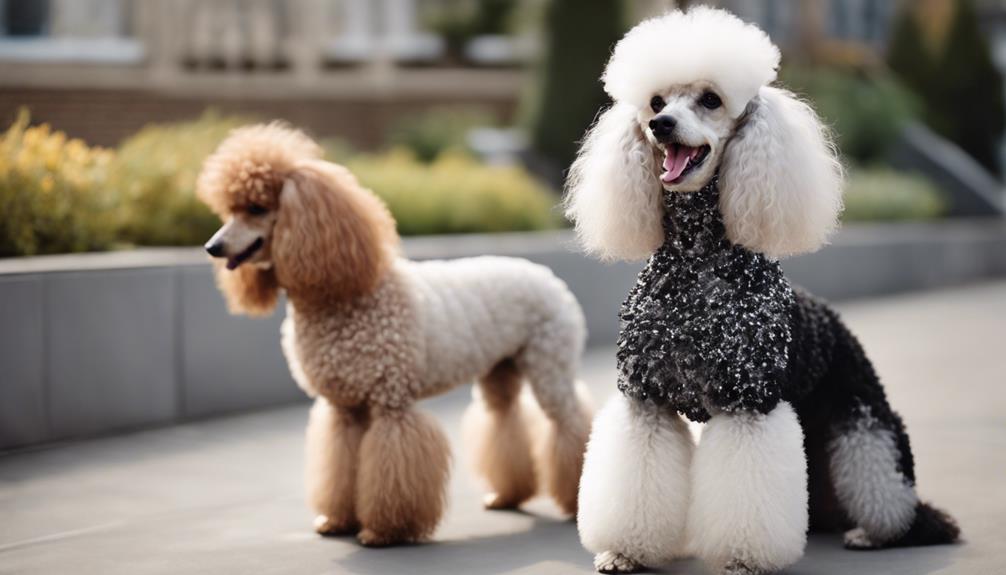When it comes to poodle coat colors, the inheritance patterns can be as intriguing as the shades themselves. Have you ever pondered why some poodles have solid-colored coats while others display a mix of hues? The genetics behind poodle coat colors hold a multitude of secrets waiting to be unraveled. From the subtle variations in black to the warm tones of apricot and red, the intricacies of poodle coat genetics are as fascinating as they are complex. So, what secrets do the genes hold about your poodle's coat color palette?
Key Takeaways
- Ay, Aw, and At alleles determine diverse coat colors in poodles.
- Genetic testing enables precise prediction and selection of coat color outcomes.
- Breeding strategies focus on at allele interactions for specific color patterns.
- Predictive capabilities optimize breeding programs for consistent coat color standards.
Ay Allele

When considering poodle coat colors, the Ay allele plays a crucial role in determining the presence of fawn, red, or sable coat variations. Poodles carrying the Ay allele exhibit a spectrum of red shades, ranging from deep red to lighter fawn tones. This allele directly impacts the production of phaeomelanin, the pigment responsible for the reddish and fawn hues seen in their coats. Through selective breeding, poodle breeders aim to leverage the Ay allele to achieve specific red and sable coat colors in offspring. Understanding the inheritance patterns of the Ay allele is paramount in predicting and controlling the expression of these desired pigmentation variations. By manipulating the presence of the Ay allele through strategic breeding practices, breeders can influence the richness and intensity of red and sable colors in poodle litters. This genetic component serves as a fundamental building block in the intricate palette of coat colors found within the poodle breed.
Aw Allele
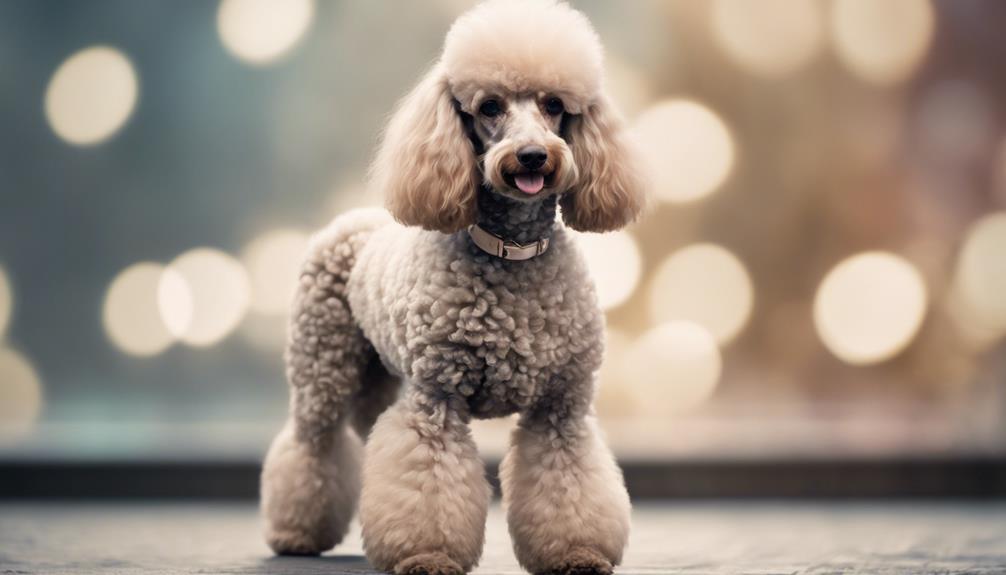
The Aw allele in poodles, a key genetic factor influencing sable coat coloration, exhibits dominance over other alleles such as at and a. Poodles carrying the Aw allele showcase a striking wild sable coat pattern, characterized by distinct variations in shading. This allele significantly contributes to the diverse spectrum of coat colors observed in poodles. Breeders can leverage DNA testing techniques to accurately identify the presence of the Aw allele in poodles, allowing for informed breeding decisions. Understanding the inheritance patterns of the Aw allele is crucial for predicting the sable coat colors that may manifest in future generations of poodle offspring. By recognizing the influence of the Aw allele on coat coloration, breeders can purposefully select for desired traits and work towards maintaining the integrity of the wild sable coat in poodles.
At Allele
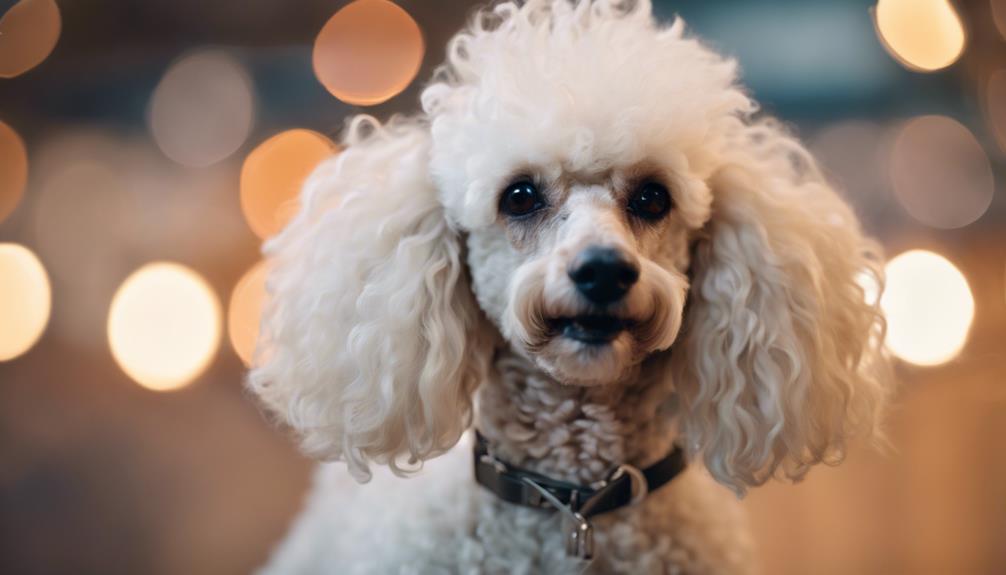
The At allele in poodles influences coat color by producing black-and-tan and tricolor patterns. This allele's dominance over the recessive a allele, responsible for black coat color, requires poodles to inherit two copies of the a allele to display a black coat. Understanding the intricate interactions of the At allele with other coat color genes is essential to predicting the diverse coat color variations seen in poodles.
Coat Color Inheritance
To understand poodle coat color inheritance involving the at allele, one must grasp the interaction of this recessive gene with dominant alleles Ay and aw. The at allele contributes to black-and-tan and tricolor coat patterns in poodles but needs two copies to be expressed. Dominant Ay and aw alleles override the at allele in coat color determination. Poodles carrying the at allele may exhibit distinctive markings or patterns on their coat. When two at allele carriers are bred, there is a possibility of the at allele inheritance in the offspring, leading to specific coat colors. Understanding the interplay between the at allele and dominant alleles Ay and aw is crucial in predicting and breeding for desired coat color outcomes in poodles.
Poodle Coat Variations
Exploring poodle coat variations involving the at allele provides insight into the intricate genetics behind black-and-tan and tricolor patterns. The at allele, crucial in determining coat color in poodles, leads to unique combinations when present. Poodles carrying the at allele need only one copy for the characteristic coloration to manifest. In breeding, understanding the dominance of the at allele over the a allele but its recessiveness to the aw and Ay alleles is essential. Predicting and achieving specific coat colors in poodles hinges on grasping the at allele's inheritance patterns. By delving into the at allele's role in coat color determination, breeders can strategically work towards producing desired black-and-tan or tricolor poodle variations.
A Allele
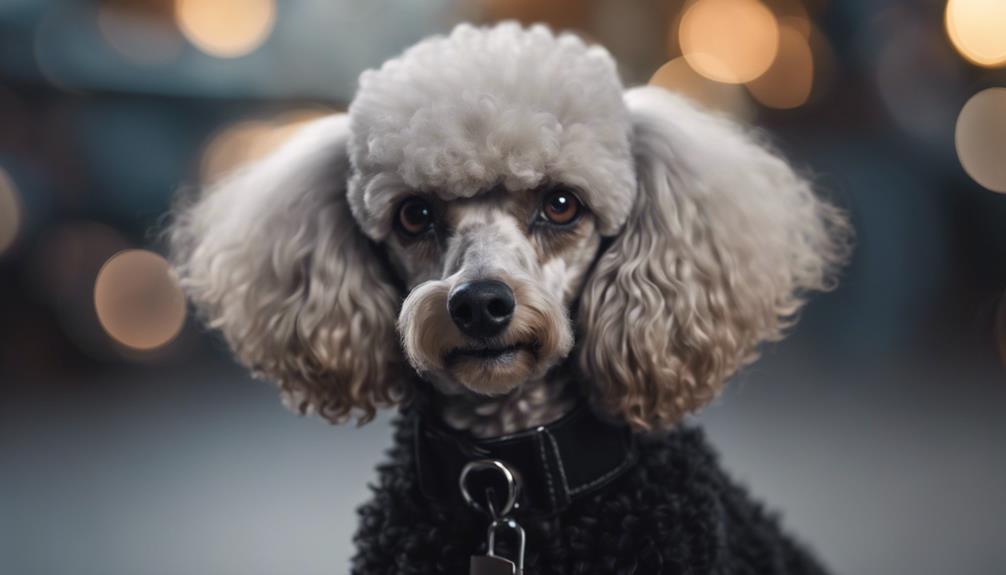
Analyzing the genetics of poodle coat colors reveals the significance of the A allele in determining specific color variations. The A allele, also known as the recessive black gene in poodles, requires two copies for expression. Here's how the A allele influences coat colors in poodles:
- Poodles with two copies of the A allele will exhibit a solid black coat color.
- When paired with other alleles, the A allele can influence coat color variations in poodles.
- Breeding two poodles with the A allele can result in offspring with the potential for black coat coloration.
Understanding the inheritance of the A allele is crucial for predicting and producing specific coat colors in poodles. By recognizing how the A allele operates in coat color determination, breeders can make informed decisions to achieve desired outcomes in poodle coat variations.
B-Locus (Brown, Liver, Chocolate)
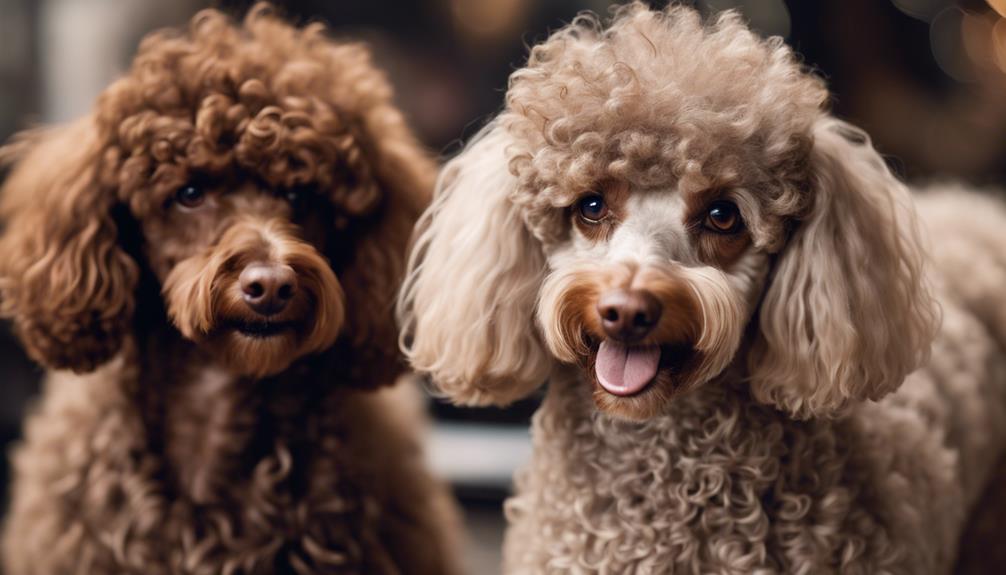
Examining the B-Locus in poodles provides insight into the genetic basis for brown, liver, and chocolate coat colors in this breed. The B gene, located on the B-Locus, plays a crucial role in determining whether a poodle will have a brown coat. Poodles with the bb genotype express brown coat color due to the production of specific melanin-related proteins. On the other hand, poodles with alternate B alleles typically exhibit black or other coat colors. By understanding the B-Locus genetics, breeders can predict and manipulate coat color outcomes through selective breeding strategies.
| Genotype | Coat Color |
|---|---|
| bb | Brown |
| Bb | Black or other |
| BB | Black or other |
Breeding poodles with specific B-Locus genotypes can lead to a variety of coat colors within litters. This knowledge is crucial for maintaining and enhancing specific coat colors in poodles, particularly the desirable brown, liver, or chocolate hues. Understanding the B-Locus genetics empowers breeders to make informed decisions that positively impact coat color outcomes.
D-Locus Testing
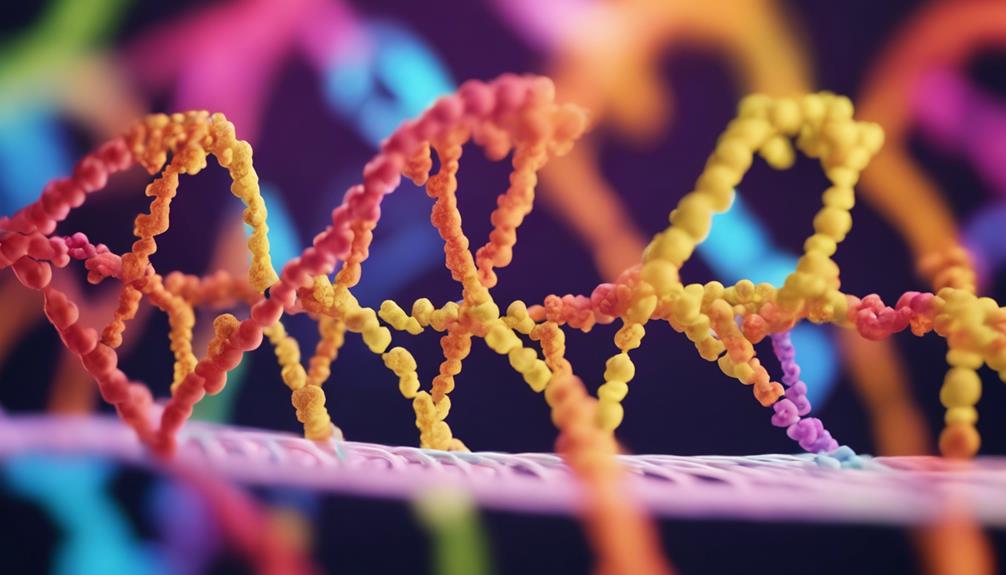
To understand the impact of D-Locus testing on poodle coat colors, consider how this genetic analysis reveals the presence of the dilute gene responsible for coat color dilution.
- D-Locus testing in poodles helps identify the dilute gene, crucial for determining coat color outcomes.
- Results from this test can confirm dilution in colors like blue, silver, and lilac.
- Poodles with two copies of the dilute gene (dd) exhibit diluted coat colors, while those with one copy (Dd) may carry the gene without showing dilution.
Breeders rely on D-Locus testing to predict and control coat color variations in their poodles. Understanding the D-Locus status is essential for ensuring specific coat color outcomes, especially when breeding for unique colors like silver or lilac. By utilizing this genetic analysis, breeders can make informed decisions to enhance and maintain the desired coat color traits in their poodle lines.
E-Locus Testing

E-Locus testing in poodles reveals specific alleles influencing coat color variations by targeting the MC1R gene responsible for eumelanin and phaeomelanin synthesis. This testing is essential for dog breeders looking to understand the genetics of coat color bred in poodles. The E allele, a recessive gene, plays a significant role in determining coat color outcomes. For instance, in apricot poodles, the presence or absence of specific E alleles can impact the expression of colors. By analyzing the E-Locus alleles, breeders can predict and control coat color genetics in their breeding programs more effectively.
Understanding the intricacies of E-Locus testing provides valuable insights into the potential coat color outcomes in dogs. This knowledge empowers breeders to make informed decisions to maintain desired coat color standards within the poodle breed. By leveraging E-Locus testing results, breeders can work towards producing poodles with specific coat color traits, contributing to the diversity and beauty of this beloved breed.
K-Locus Testing

K-Locus testing analyzes the presence of dominant black (KB) or recessive black (ky) alleles in poodles to determine potential coat color variations. When considering breeding decisions for black poodles, understanding the genotype through K-Locus testing is crucial. Here are some key points to consider:
- The KB allele results in a black coat color in poodles, while the ky allele necessitates two copies for manifestation.
- Poodles with a genotype of KB/ky can exhibit black pigmentation that is diluted to shades of gray or silver, leading to a variety of coat color outcomes.
- By identifying the presence of KB or ky alleles through K-Locus testing, breeders can make informed decisions to achieve specific coat colors in their poodles, ensuring the desired black pigment in their offspring.
Utilizing K-Locus testing in breeding programs enhances the ability to predict and control coat color variations, ultimately contributing to the production of black poodles with desired characteristics.
Frequently Asked Questions
What Is the Rarest Color of Poodle?
The rarest color of Poodle is the Phantom, which combines two distinct coat colors. Phantom Poodles showcase specific markings above the eyes, on the muzzle, chest, and under the tail. Breeders and enthusiasts highly prize their striking appearance.
What Color Will My Poodle Puppies Be?
When breeding poodles, coat inheritance involves genetic variations that influence color prediction. Consider breeding strategies to create diverse color combinations. Genetic testing can reveal coat pigmentation genes, aiding in phenotypic expression and enhancing coat diversity.
What Are the Genes for Dog Coat Color?
Genetic variations in dogs dictate coat patterns through inheritance patterns. Color pigmentation is controlled by genes like TYRP1 and MC1-R. Breeding strategies consider DNA sequencing for chromosomal mutations to predict phenotypic traits, aided by genetic testing.
What Determines a Dog's Fur Color?
In determining a dog's fur color, pigment production, genetic variations, melanin levels, coat patterns, environmental factors, breeding techniques, color dilution, crossbreeding effects, and health implications intertwine. A complex dance of genes orchestrates the vibrant palette of canine coats.
Conclusion
Now that we have explored the intricate genetics of poodle coat colors, it is clear that the possibilities are endless. With the potential combinations of alleles and loci, breeders can create stunning variations in coat colors. By understanding the complex interactions of genes like TYRP1 and B-Locus, we can unlock the secrets behind each poodle's unique phenotype. The future of coat color genetics in poodles holds endless surprises and discoveries waiting to be revealed.
